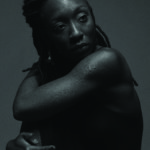 Virgilia Griffith
Virgilia Griffithphoto: Jim Ryce
At the Tarragon Theatre, Toronto, Ont.
Written and directed by Djanet Sears
Set and costumes by Astrid Janson
Lighting by André du Toit
Sound and music director, Allen Booth
Cast: Walter Borden
Beau Dixon
Virgilia Griffith
Tiffany Martin
Ordena Stephens-Thompson
Musicians:
Bryant Didier
Cymphoni Fantastique
Harlem Duet is poetically and intellectually bracing and Djanet Sears and her stellar cast rise to the beautiful and gripping challenges of the play.
The Story. Playwright Djanet Sears has taken Shakespeare’s Othello story and turned it on its ear. In Shakespeare’s play Othello, a moor and a brilliant military man, has secretly married Desdemona, a beautiful white woman, much against her father’s wishes. Trouble brews.
Iago is a man who professes to support Othello but is really jealous of Othello’s rise in the ranks and plots to work on Othello’s jealousy and will make mischief for Othello and Desdemona.
Playwright Djanet Sears takes the basic story of Othello and Desdemona and has written Harlem Duet as a prequel—what happened before Othello and Desdemona got together.
Harlem Duet takes place in three time periods: Harlem, N.Y in 2000, Harlem, New York in 1928 and then Harlem, Georgia in 1860 during the time of slavery.
In Harlem, New York in 2000, Billie is a graduate student and her husband Othello teaches in the English department of a university. Both are black. Billie learns that Othello is in love with a white woman named Mona. She is distraught.
In Harlem, Georgia in 1860 has a black slave couple planning to escape but there is a glitch. And in Harlem in 1928, we have a variation on that theme of trying to find happiness with a partner.
In Djanet Sears’ play the women are the ones leading and stronger, in a way. The plot twists echo Shakespeare’s play but with dazzling variations by Djanet Sears. Certainly in the scenes in 2000 both Billie and Othello discuss being black and in a relationship. For her its political. For him it’s a weight around his neck.
The Production. The production is fabulous. Designer Astrid Janson has created a stunning set that has three separate playing areas for the three time periods, that occasionally blend. Up at the back is a big double bed for the scenes in 2000. Down stage right is a kitchen with an old fridge and a simple table that are used for the 1928 scenes. And between the two is a v shaped wedge dug into the earth with cotton plants growing on either side of the wedge setting the scenes in Harlem, Georgia in 1860. Sometimes a character will walk through the 1928 kitchen to the bedroom set in 2000.
Janson’s costumes also indicate the separation of time periods. In the Harlem, Georgia scenes in 1860 Othello is a blacksmith who wears a brown apron over his undershirt while he pounds horse’s hooves. “Billie” wears a peasant dress and her hair is up.
In the scenes in Harlem, New York, 1928 Othello wears an undershirt and Billie wears a slip. In the Harlem, New York scenes in 2000 Othello wears a shirt and Billie wears a dressing gown over her slip. Scenes flow seamlessly as actors put on a shirt or dressing gown, or take them off as they segue from scene to scene.
Djanet Sears also directs her own play, beautifully. The direction is very clear and we always know where we are and what year it is. Djanet Sears is a wonderful, sensitive director who of course knows how to illuminate all the nuance and facts in her play.
It’s a work of gut-wrenching beauty.
As Billie, Virgilia Griffith is a volcano of welled-up emotion that builds and builds until it erupts in Act II with devastating results. At times she is so fragile and at others she is incandescent with anger and humiliation. Virgilia Griffith’s work goes from strength to strength.
As Othello, Beau Dixon has stature, a grace with trying to reason with Billie, and he’s conflicted with his love for both Billie and Mona. This is not a cruel man even though he leaves Billie heartbroken. Indeed compassion seems to be the watchword for this production. Billie’s father Canada (buoyant Walter Borden) has long been absent and she is cold to him when he comes home to see her. Her father takes her coldness in his stride. He feels she needs him and he won’t be frightened away. The last scene is heart-squeezing.
Two musicians play the most exquisite music: Cymphoni Fantastique plays the cello beautifully and Bryant Didier plays the bass beautifully as well.
This Harlem Duet is a fantastic play that has stood the test of our troubled times.
Comment. As we know Othello leaves Billie for Mona. Billie is devastated but this doesn’t mean that Sears comes down hard on Othello because of his behaviour. She’s much too good a playwright for that. She gives him a glorious speech in which he explains that having this relationship with a white woman means he doesn’t have to watch his every word for fear of offending her, as he seems to with Billie. He can enjoy the moment. He is not diminished as a black man. He can just be. Sears treats Othello with compassion and respect. There are many sides to the relationship with Billie. Sears shows us Billie’s devotion, disappointment and pain. And she shows us Othello’s compassion for Billie but also his need to be strong and his reasons for leaving her.
Certainly recent events in the news inform this play unintentionally. Most important is that Sears has written a powerful analysis of race, relationships, guilt and love.
Tarragon Theatre presents:
Opened: Sept. 26, 2018.
Closes: Oct. 28, 2018.
Running Time: 2 hours, 30 min. approx.
www.tarragontheatre.com